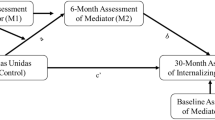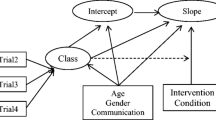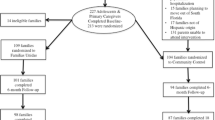Abstract
Studies document that there are efficacious interventions to prevent adolescent depression and internalizing symptoms, including several family-focused interventions. Questions remain about for whom interventions work (moderation) and by what mechanisms they work (mediation) to prevent internalizing symptoms. Unfortunately, single trials are often underpowered to address moderation and mediation, an issue addressed in this paper. This synthesis study combined individual-level, longitudinal data from 721 adolescents across 3 randomized clinical trials of Familias Unidas, a family-focused prevention intervention for Hispanic youth. Using integrative data analysis (IDA) methods applied to trials, the study examined intervention moderation and mediation effects on internalizing symptoms. Baseline internalizing symptoms were a significant moderator of the intervention’s effects on internalizing symptoms, while baseline externalizing symptoms did not moderate intervention effects. Baseline parent–adolescent communication, a modifiable risk factor and hypothesized mechanism by which the intervention works, significantly moderated the intervention’s effects. Specifically, the intervention was more efficacious in its impact on internalizing symptoms for youth with lower initial levels of parent–adolescent communication compared to those with higher communication levels. Moderated mediation analyses showed that parent–adolescent communication changes mediated the intervention’s effects on internalizing symptoms, with stronger effects for those with poorer baseline communication. Results suggest a potential benefit of identifying youth risks prior to interventions, and targeting specific modifiable mediators that lead to reductions of internalizing problems of adolescents. Findings also highlight advantages of utilizing data from combined trials and IDA for examining intervention moderators and mediators.



Similar content being viewed by others
References
Barnes, H. L., & Olson, D. H. (1985). Parent-adolescent communication and the circumplex model. Child Development, 56, 438–447.
Beardslee, W. R., Gladstone, T. R., Wright, E. J., & Cooper, A. B. (2003). A family-based approach to the prevention of depressive symptoms in children at risk: Evidence of parental and child change. Pediatrics, 112, 119–131.
Brown, C. H. (1993). Statistical methods for preventive trials in mental health. Statistics in Medicine, 12, 289–300.
Brown, C. H., Sloboda, Z., Faggiano, F., Teasdale, B., Keller, F., Burkhart, G., et al. (2011). Methods for synthesizing findings on moderation effects across multiple randomized trials. Prevention Science, 14, 144–156.
Brown, C. H., Wang, W., Kellam, S. G., Muthén, B. O., Petras, H., Toyinbo, P., et al. (2008). Methods for testing theory and evaluating impact in randomized field trials: Intent-to-treat analyses for integrating the perspectives of person, place, and time. Drug and Alcohol Dependence, S95, S74–S104.
Cleveland, W. S. (1981). LOWESS: A program for smoothing scatterplots by robust locally weighted regression. The American Statistician, 35, 54.
Compas, B., Champion, J., Forehand, R., Cole, D., Reeslund, K., Fear, J., et al. (2010). Coping and parenting: Mediators of 12-month outcomes of a family cognitive-behavioral preventive intervention with families. Journal of Consulting and Clinical Psychology, 78, 623–634.
Connell, A. M., & Dishion, T. J. (2008). Reducing depression among at-risk early adolescents: Three year effects of a family-centered intervention embedded within schools. Journal of Family Psychology, 22, 574–585.
Curran, P. J., & Hussong, A. M. (2009). Integrative data analysis: The simultaneous analysis of multiple data sets. Psychological Methods, 14, 81–100.
Gibbons, R. D., Brown, C. H., Hur, K., Davis, J., & Mann, J. J. (2012). Suicidal thoughts and behavior with antidepressant treatment: Reanalysis of the randomized placebo-controlled studies of fluoxetine and venlafaxine. Archives of General Psychiatry, 69, 580–587.
Gonzales, N. A., Dumka, L. E., Millsap, R. E., Gottschall, A., McClain, D. B., Wong, J. J., et al. (2012). Randomized trial of a broad preventive intervention for Mexican American Adolescents. Journal of Consulting and Clinical Psychology, 81, 1–16.
Horowitz, J. L., & Garber, J. (2006). The prevention of depressive symptoms in children and adolescents: A meta-analytic review. Journal Consulting and Clinical Psychology, 74, 401–415.
Kessler, R. C., Avenevoli, S., Costello, J., Georgiades, K., Greif Green, J., Gruber, M. J., et al. (2012). Prevalence, persistence, and sociodemographic correlates of DSM-IV Disorders in the National Comorbidity Survey Replication Adolescent Supplement. Archives of General Psychiatry, 69, 372–380.
Klein, A. G., & Muthén, B. O. (2007). Quasi-maximum likelihood estimation of structural equation models with multiple interaction and quadratic effects. Multivariate Behavioral Research, 42, 647–673.
Kraemer, H. C., Kiernan, M., Essex, M., & Kupfer, D. J. (2008). How and why the criteria defining moderators and mediators differ between the Baron & Kenny and MacArthur Approaches. Health Psychology, 27, S101–S108.
Lucas, C. P., Zhang, H., Fisher, P. W., Shaffer, D., Regeir, D. A., Narro, W. E., et al. (2001). The DISC Predictive Scales (DPS): Efficiently screening for diagnoses. Journal American Academy of Child and Adolescent Psychiatry, 40, 443–449.
MacKinnon, D. P. (2008). Introduction to statistical mediation analysis. New York: Erlbaum.
McCombs-Thomas, A., Forehand, R., Armistead, L., Wierson, M., & Fauber, R. (1990). Cross-informant consistency in externalizing and internalizing problems in early adolescence. Journal of Psychopathology and Behavioral Assessment, 12, 255–262.
Merry, S.N., Hetrick, S.E., Cox, G.R., Brudevold-Iverson, T., Bir, J.J., & McDowell, H. (2012). Psychological and educational interventions for preventing depression in children and adolescents. Cochrane Database of Systematic Reviews, 12, Art No. CD003380.
Muñoz, R. F., Beardslee, W. R., & Leykin, Y. (2012). Major depression can be prevented. American Psychologist, 67, 285–295.
Muthén, L. K., & Muthén, B. O. (2012). Mplus: Statistical analysis with latent variables: User’s guide. Los Angeles: Muthén & Muthén.
National Research Council/ Institute of Medicine. (2009). Preventing mental, emotional, and behavioral disorders among young people: Progress and possibilities. In M. O’Connell, T. Boat, & K. Warner (Eds.), Committee on the Prevention of Mental Disorders and Substance Abuse among Children, Youth, and Young Adults. Washington: National Academies Press.
Oland, A. A., & Shaw, D. S. (2003). Pure versus co-occurring externalizing and internalizing symptoms in children: The potential role of sociodevelopmental milestones. Clinical Child and Family Psychology Review, 8, 247–270.
O’Rourke, H. P., & MacKinnon, D. P. (2013). When the mediation model can be used to increase statistical power. Manuscript in preparation.
Pantin, H., Prado, G., Lopez, B., Huang, S., Tapia, M. I., Schwartz, S., et al. (2009). A randomized controlled trial of Familias Unidas for Hispanic adolescents with behavior problems. Psychosomatic Medicine, 71, 987–995.
Prado, G., Cordova, D., Huang, S., Estrada, Y., Rosen, A., Bacio, G. A., et al. (2012). The efficacy of Familias Unidas on drug and alcohol outcomes for Hispanic delinquent youth: Main effects and interaction effects by parental stress and social support. Drug and Alcohol Dependence, 125S, S18–S25.
Prado, G., & Pantin, H. (2011). Reducing substance use and HIV health disparities among Hispanic youth in the USA: The Familias Unidas program of research. Intervención Psicosocial, 20, 63–73.
Prado, G., Pantin, H., Briones, E., Schwartz, S., Feaster, D., Huang, S., et al. (2007). A randomized controlled trial of a parent-centered intervention in preventing substance use and HIV risk behaviors in Hispanic adolescents. Journal of Consulting and Clinical Psychology, 75, 914–926.
Preacher, K. J., Rucker, D. D., & Hayes, A. F. (2007). Addressing moderated mediation hypotheses: Theory, methods, and prescriptions. Multivariate Behavioral Research, 42, 185–227.
Quay, H. C., & Peterson, D. R. (1993). The Revised Behavior Problem Checklist: Manual. Odessa: Psychological Assessment Resources.
Restifo, K., & Bogels, S. (2009). Family processes in the development of youth depression: Translating the evidence to treatment. Clinical Psychology Review, 29, 294–316.
Sandler, I. N., Ayers, T. S., Wolchik, S. A., Tein, J. Y., Kwok, O. M., Haine, R. A., et al. (2003). The Family Bereavement Program: Efficacy evaluation of a theory-based prevention program for parentally bereaved children and adolescents. Journal of Consulting and Clinical Psychology, 71, 587–600.
Sandler, I. N., Schoenfelder, E. N., Wolchik, S. A., & MacKinnon, D. P. (2011). Long-term impact of prevention programs to promote effective parenting: Lasting effects but uncertain processes. Annual Review of Psychology, 62, 299–329.
Stice, E., Shaw, H., Bohon, C., Marti, C. N., & Rohde, P. (2009). A meta-analytic review of depression prevention programs for children and adolescents: Factors that predict magnitude of intervention effects. Journal of Consulting and Clinical Psychology, 77, 486–503.
Tein, J. Y., Sandler, I. N., MacKinnon, D. P., & Wolchik, S. A. (2004). How did it work? Who did it work for? Mediation in the context of a moderated prevention effect for children of divorce. Journal of Consulting and Clinical Psychology, 72, 617–624.
Trudeau, L., Spoth, R., Randall, G. K., Mason, W. A., & Shin, C. (2012). Internalizing symptoms: Effects of a preventive intervention on developmental pathways from early adolescence to young adulthood. Journal of Youth and Adolescence, 41, 788–801.
Valeri, L., & VanderWeele, T. J. (2013). Mediation analysis allowing for exposure-mediator interactions and causal interpretation: theoretical assumptions and implementation with SAS and SPSS macros. Psychological Methods, 18, 137–150.
Young, J. F., Gallop, R., & Mufson, L. (2009). Mother-child conflict and its moderating effects on depression outcomes in a preventive intervention for adolescent depression. Journal of Clinical Child and Adolescent Psychology, 38, 696–704.
Zhou, Q., Sandler, I. N., Millsap, R. E., Wolchik, S. A., & Dawson- McClure, S. R. (2008). Mother–child relationship quality and effective discipline as mediators of the 6-year effects of the New Beginnings Program for children from divorced families. Journal of Consulting and Clinical Psychology, 76, 579–594.
Author information
Authors and Affiliations
Corresponding author
Additional information
Author Note
Tatiana Perrino, Hilda Pantin, Guillermo Prado, Shi Huang, and Ahnalee Brincks are at the Miller School of Medicine, University of Miami in Miami, FL. George Howe is at George Washington University in Washington, DC. William Beardslee is at Children’s Hospital-Boston and Harvard University-Cambridge, MA. Irwin Sandler is at Arizona State University in Tempe, AZ. C Hendricks Brown is at the Feinberg School of Medicine, Northwestern University in Chicago, IL.
This work was supported by the following grants: National Institute of Mental Health Grant No. R01MH040859 (C. Hendricks Brown, PI); National Institute of Mental Health Grant No. R01MH61143 (Jose Szapocznik, PI); National Institute on Drug Abuse Grant No.R01DA017462 (Hilda Pantin, PI); and National Institute on Drug Abuse Grant No R01DA025894 (Guillermo Prado, PI).
Rights and permissions
About this article
Cite this article
Perrino, T., Pantin, H., Prado, G. et al. Preventing Internalizing Symptoms Among Hispanic Adolescents: A Synthesis Across Familias Unidas Trials. Prev Sci 15, 917–928 (2014). https://doi.org/10.1007/s11121-013-0448-9
Published:
Issue Date:
DOI: https://doi.org/10.1007/s11121-013-0448-9




